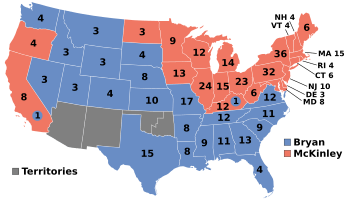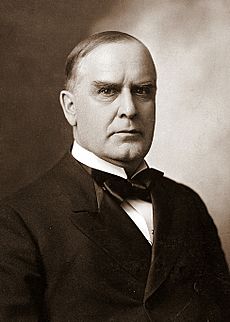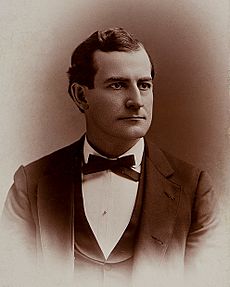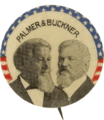1896 United States presidential election facts for kids
|
||||||||||||||||||||||||||||||||
|
All 447 electoral votes of the Electoral College 224 electoral votes needed to win |
||||||||||||||||||||||||||||||||
|---|---|---|---|---|---|---|---|---|---|---|---|---|---|---|---|---|---|---|---|---|---|---|---|---|---|---|---|---|---|---|---|---|
| Turnout | 79.3% |
|||||||||||||||||||||||||||||||
|
||||||||||||||||||||||||||||||||
 Presidential election results map. Red shows those won by McKinley/Hobart, blue shows states won by Bryan/Sewall and the Populist ticket of Bryan/Watson. Numbers show the number of electoral votes given to each state.
|
||||||||||||||||||||||||||||||||
|
||||||||||||||||||||||||||||||||
The 1896 United States presidential election was a big event in American history. It was the 28th time Americans voted for their president. This election happened on Tuesday, November 3, 1896.
In this election, William McKinley, who was the Republican candidate, won. He defeated William Jennings Bryan, the Democratic candidate. The election took place during a tough economic time called the Panic of 1893. This period was a serious economic downturn.
Many people see the 1896 election as a turning point. It marked a shift in how political parties worked in the United States. It moved from one major political era to another.
Contents
Understanding the 1896 Election
The 1896 election was very important for the United States. It showed a big change in how politics worked. It also showed how the country dealt with money problems.
Who Were the Main Candidates?
- William McKinley: He was the candidate for the Republican Party. McKinley had been a governor of Ohio. He was known for supporting businesses and a strong economy. His running mate was Garret Hobart.
- William Jennings Bryan: He was the candidate for the Democratic Party. Bryan was from Nebraska. He was also supported by the People's Party and the Silver Party. Bryan was famous for his powerful speeches. His running mates were Arthur Sewall (for Democrats and Silver Party) and Thomas E. Watson (for the Populist Party).
What Was the Economy Like?
The election happened during the Panic of 1893. This was a severe economic depression. Many people lost their jobs. Businesses struggled, and farmers faced hard times. The economy was a major topic during the election.
What Were the Big Issues?
The main issue in the 1896 election was about money. It was called the "gold standard" versus "free silver."
- Gold Standard: Republicans, led by McKinley, wanted the country's money to be based only on gold. They believed this would make the economy stable.
- Free Silver: Democrats and Populists, led by Bryan, wanted to use both gold and silver to back the money. They thought this would make money more available. They believed it would help farmers and people in debt.
Bryan gave a very famous speech called the "Cross of Gold" speech. In it, he argued strongly for using silver.
How Did the Election Turn Out?
William McKinley won the election. He received 271 electoral votes. William Jennings Bryan received 176 electoral votes. McKinley also won the popular vote. He got about 7.1 million votes, while Bryan got about 6.5 million votes.
McKinley won most of the states in the Northeast and Midwest. Bryan won many states in the South and West. The election showed a clear split in the country.
Images for kids
-
Cartogram of presidential election results by county
- United States presidential election of 1896 at Encyclopædia Britannica
See also
 In Spanish: Elecciones presidenciales de Estados Unidos de 1896 para niños
In Spanish: Elecciones presidenciales de Estados Unidos de 1896 para niños


















